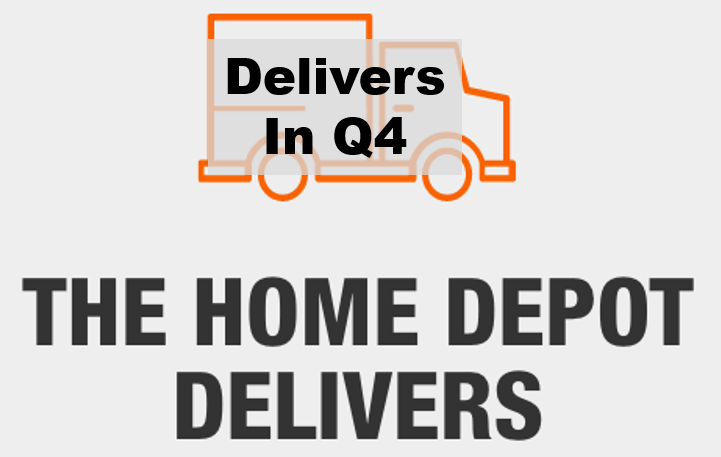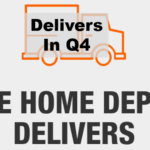Home Depot Delivers for the Year … and For Pros

Home Depot shared its fourth quarter earnings report today. Overall, they ended the year hitting it out of the park. While they obviously benefited from COVID and the “stay at home” and building boom, they also reaped the rewards of planning, investing for the long-haul and are seeing their Pro business accelerate.
Let’s look at some highlights and the lessons, or takeaways, for distributors and possibly manufacturers.
From the Home Depot fourth quarter analyst call:
- For Q4, up 25.1% to $32 billion for the quarter
(wonder what % is electrical sales. Years ago, Home Depot, the retail group,
did 6% of sales in electrical. Today, across all its platforms – retail, Pro?
HD Facilities Maintenance? And then wonder “by channel” – in store, online,
other? – some manufacturer(s) probably know from an HD presentation or can
estimate.)
- The company GREW $21 billion in 2020.
- For the year, Home Depot sales were $132.1 billion, up 19.9%
- Investments made in the business over past
decade “were the right ones”. (shows value of planning and investing to the
plan.)
- Investments enabled agility and flexibility.
- Included investments in technology and infrastructure
- Mechanization of upstream supply chain for better flow of products and information.
- Leverage data analytics for merchants (purchasing management tools)
- Enhance digital experience for customers
- Focus on customer experience.
- Blend physical and digital worlds / experience (something distributors should focus more on, as should manufacturers but from multiple perspectives. Digital is an extension of a buying process, not something “different” or “unique” and, for manufacturers, it is not a channel, it is an end-user buying method.)
- Double digit growth in Pro sales! (although
DIY was stronger)
- Growth from larger Pro customers continued to accelerate with their customers reporting growing backlogs
- Smaller Pro customers continued with double-digit growth in every month (wondering where small customers are going, especially resi-oriented contractors? The renovation / service market? This has significant implications for how certain companies / product categories serve this market … and the question becomes – are electrical distributors going to slowly lose this market? Manufacturers have been asking this question more this year!)
- All merchandising departments posted double digit comps (means electrical also!)
- Web sales increased 86% (and yes, much is retail). Also reimagined their workshops with now all being online. Went from 5 to 40 per month. They state “deeper engagement” but, and this may be interesting, they are livestreaming them. (While manufacturers have done webinars for distributors (and distributors for some of their customers) and manufacturers have done these “direct”, perhaps the timings need to vary, and promotion or archived sessions need to be promoted (and aggregated on a site) as well as the sessions then segmented into “chapters” to be “consumable snippets”? Longer-term – a compilation of live, recorded, and livestreamed will be desired … different modes for different audiences.)
- Cordless tool market is growing strong. Promoting cordless tools by branded battery platform with focus on Makita, Milwaukee, Ryobi, Toro and DeWalt (these brands are for outdoor power equipment). (The implication for distributors is that if you have a viable tool business, perhaps decide what platform(s) to support and focus. Support the decision with “voice of customer” research. It’s not a big category for electrical distributors but it can drive some traffic.)
- Inventory turns were 5.8 vs 4.9 from prior year (while an apples to oranges comparison, it highlights that focusing on “the right skus”, active inventory management and volume drive inventory utilization. As a manufacturer, the question becomes, what are your turns in HD vs their electrical turns and in your category? Same question within the electrical channel? Are you a profitable line for a distributor to stock?)
- Plan to invest 2% of sales in capital expenditures. (Question – how do you plan your expenses, or investments, in areas? Is it zero-based and project specific or are you committed to investing and invest x% in different areas … inclusive of strategic? Do you have your own “venture capital” fund for “piloting” / capitalizing upon opportunities? Are you looking forward or playing for today?)
Insights from Analyst Questions
- Expect to see continued pressure from transportation costs.
- Opening “One Supply Chain” buildings to support one-day delivery throughout 90% of the country (which will help them grow online business as well as Pro business.)
- HD’s goal is to “stay ahead of the customer”. This philosophy has helped them take share (reportedly 275 basis points is their best guess.)
- Goal is to “optimize operating margin dollars” / gross profit dollars (not percent)
- HD believes that HD Supply’s MRO market is a $55 billion market (and electrical distribution has a minimal percent of this. HD feels this is a very fragmented market. HD, with Interline and HD Supply, has about 10% of this market.)
- Sees digital as being an accelerator for Interline / HD Supply (the MRO market). Will reposition / expand some of their consumer digital assets to accelerate this.
So, strong overall performance with the Pro business continuing to power ahead. Home Depot has plans to learn and accelerate both its Pro business as well as its MRO business (Interline / HD Supply) and capture more this business by leveraging investments and accelerating digital outreach.
Takeaways
The takeaway is that Home Depot is
- Not going away for the Pro (construction) side of the business
- Will become more formidable in the MRO side of the business (and especially the “institution”, property management, government, education, hospitality, etc. segments)
- Will leverage supply chain investments to serve customers and lower operating costs while improving efficiency.
- Focus on gross margin dollars
- And believes in planning and following through on the plan.
While many distributors may not feel they compete with Home Depot, the question is, “do you really know?” Do you know the demographics of your customer base? Have you let the “small” market walk across the street? Will the non-industrial MRO market also migrate to HD? Is distribution left with the lower margin business? If you cannot outperform do you abandon the market or identify niches or seek an “acceptable” share?
And for manufacturers, recognizing you have a fiduciary responsibility to shareholders, can you afford not to find some way to be engaged with Home Depot? Perhaps not in-store given their limited shelf space but online? Via Interline? Via HD Supply? Worst case you may learn more about digital.
Bottom line … develop the plan, fund the plan, and work the plan with the vision of the customer at the front of the line.























